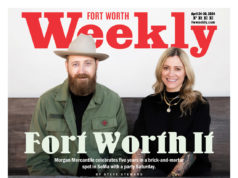One of the largest, most diverse, and most historic photography collections in Texas has finally found a home.
Consisting of more than 10,000 prints and 300,000 negatives –– plus correspondence, artifacts, and several vintage cameras –– the Williams Collection has been acquired by UNT Libraries. Documenting nearly 120 years of North Texas history and ranging in style from fine art to documentary, the photos were taken by four generations of photographers, all named Byrd Williams, including former Fort Worthian Byrd IV, who was the focal point of a Weekly cover story about him and his family in 2009 (“Byrds’-Eye View”).
Morgan Davis Gieringer, head of special collections at UNT, was introduced to the Williamses’ work via a former curator in special collections whose father was a student of Byrd IV’s at Collin County College, where he still teaches photography. Gieringer, intrigued, did some preliminary research. “Just the few images [Byrd IV] has on his website were enough to get me in touch with him right away,” she said.
Compared to the other holdings in UNT’s special collections –– the Dorothy Howard Collection (children’s games and folklore), Miniature Book Collection, Oral History Collection, Pat Warde Collection of Letters, Texana Collections, TXSSAR Archives, and the Weaver Collection of Juvenile Materials –– The Williams Collection is massive, “definitely one of our largest,” Gieringer said, “and one of the most significant additions to the UNT Library in many years. I am happy that we were able to keep the collection together and preserve the history of the Williams family all in one place.”
The earliest pieces are from Byrd Moore Williams, who owned a hardware store in Gainesville, Tex., that sold photography equipment. Son Byrd Moore Williams Jr., who studied photography at the University of Texas (1905-1907), went on to work in engineering and documented several major projects, including the San Antonio River Walk. Byrd Williams III owned a photo service in Fort Worth and in the 1930s created an expansive series of women at work. His son, Byrd IV, is the most artistically minded of the bunch, having devoted entire series to street scenes, portraits of gun crime victims, televangelists, and bathrooms.
Sets of cross-generational Williams photos belong to the Amon Carter Museum of American Art, the Harry Ransom Center at the University of Texas at Austin, the Museum of Fine Arts, Houston, and the Stadtmuseum Simeonstift in Trier, Germany.
UNT, Byrd IV said, contacted him about two years ago. For the collection, Byrd said he also had received offers from the Dolph Briscoe Center for American History at the UT, the Fort Worth Museum of Science and History, the Southwest Museum and Millennium Collection at Texas Tech University, and the University of Texas at Arlington. “What was enticing about UNT: They have a university press, and they offered me a book deal,” Byrd IV said. “For me, that would cap off my life.”
He added that there was “something wrong” with every other deal extended to him. “They wanted to separate the collection … and some [schools] didn’t want the horrible [and extremely flammable] nitrate negatives,” he said. UNT, he added, “took everything.”
Byrd IV said he feels “really good” about the UNT deal. That historians and future generations will be able to experience the collection in its entirety is “satisfying,” he said. “I have a lot of photographer friends who have died, like [legendary Fort Worthian] Peter Feresten, and who knows where their work is.”
There is a bad side, though, Byrd IV said. “I’ve had some neurosis over it,” he said. “My dad gave me this collection in 1970, and I’ve moved 18 times. I’ve been schlepping it everywhere, and, in general, I’ve always had it around me. I’ve kind of rifled through it, and now it belongs to someone else, and that was kind of a shock, but I’ve made peace with it.”
The collection, he continued, “crosses all that time. From the time my granddad took photos of Pancho Villa until I photographed the queen of England, I’ve had to explain everything to everybody. … If something happened to me now, [the collection] could be explained by someone else.”
The collection, UNT library officials said, is currently being processed and will be available for research in the near future.
“As more students and scholars recognize the important role of visual images in our culture, photography is becoming an increasingly important subject matter and material type to include in our collections,” Gieringer said. “This collection presents wonderful opportunities for students or scholars engaged in work involving commercial and studio photography, Western landscapes, documentary studies, and fine art. In addition, the library has plans to share the collections through exhibitions and publications. This collection is too good to keep locked up in the vault.”












